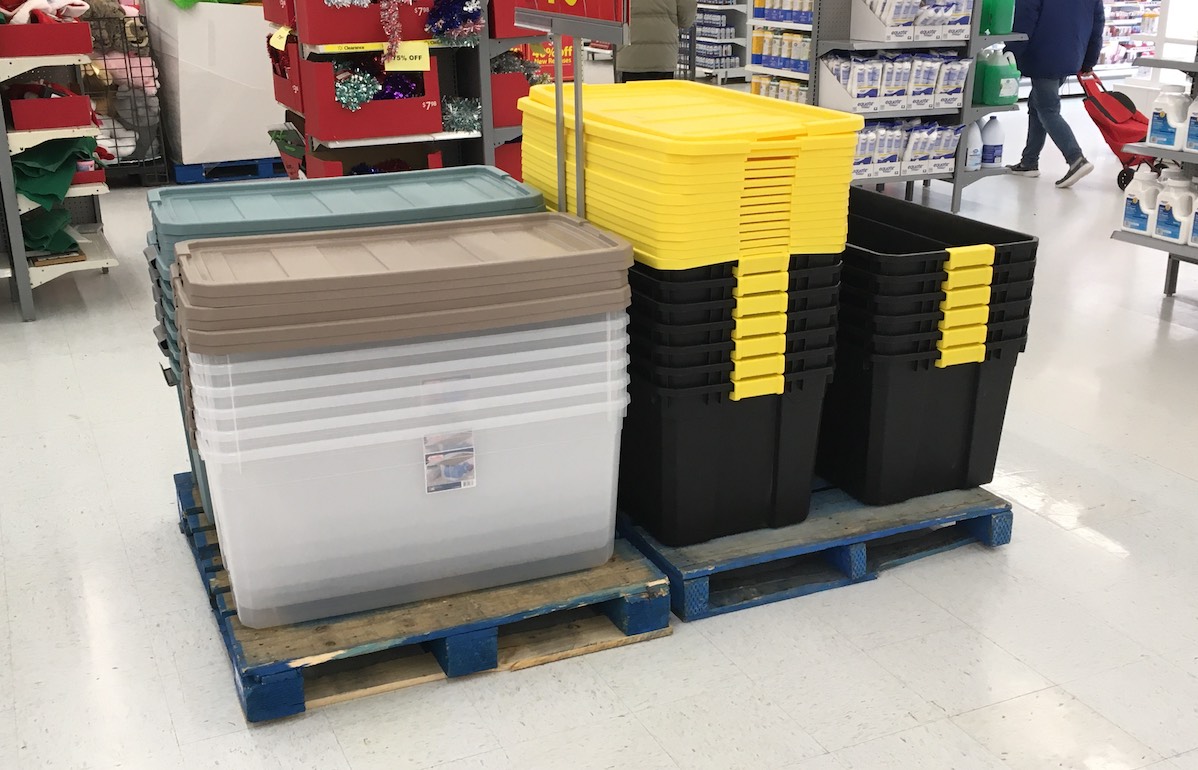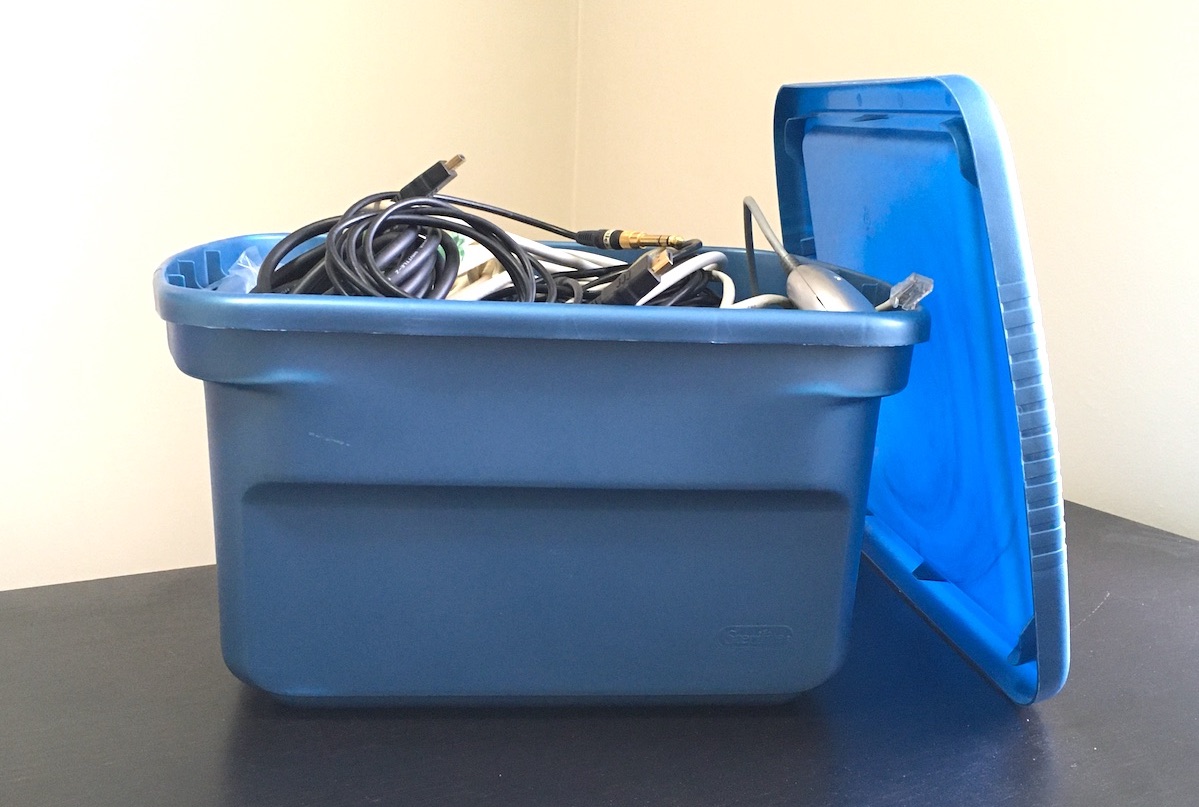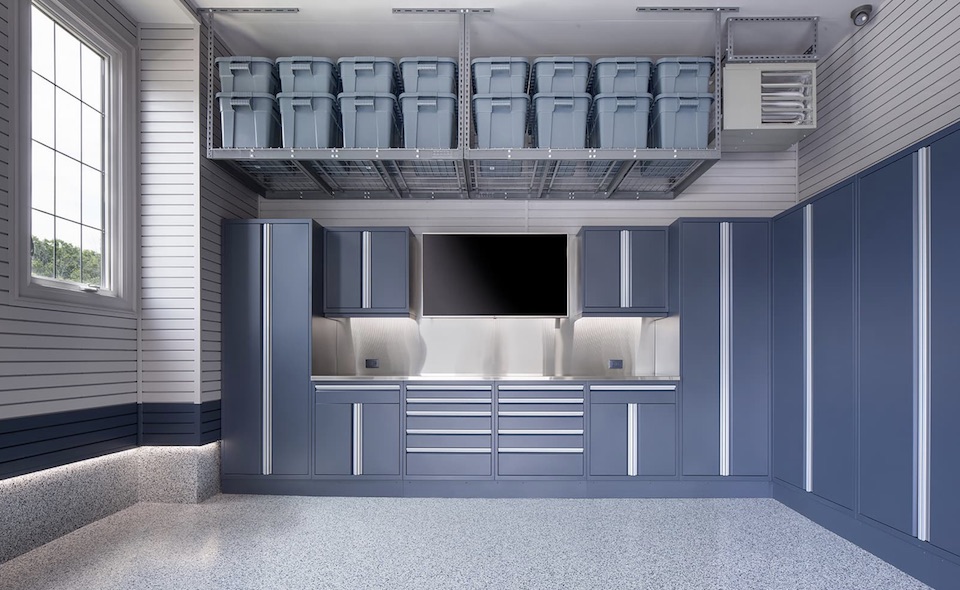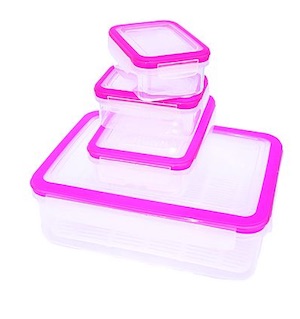
Some things in January are as predictable as clockwork.
New Year’s resolutions. Regret over how much we consumed during the holiday season. Packing up the holiday decorations. And storage container sales at seemingly every store around.
Being inundated with reminders that we need to buy more plastic storage containers, bins, tubs, totes, or whatever you call them (and at a deep discount!) is admittedly smart marketing by retailers.
Many of us are feeling that urge to get our homes organized to start the new year off on a positive and productive note. And picking up some more storage containers probably seems like a practical way to help us do that.
But are storage containers really helping you get organized or are they actually (and ironically) adding to your household clutter?
Here’s why you should think twice before buying from any more storage container sales.
Buying from storage container sales won’t help reduce clutter
Merriam Webster defines clutter as “to fill or cover with scattered or disordered things that impede movement or reduce effectiveness” and “a crowded or confused mass or collection”.
Merely moving loose, scattered things on your floors or in your closets into storage bins doesn’t subtract from that confused mass or collection, however.
An average-sized storage container holds approximately 50-60 L. Its length is about 16″ wide and 24″ deep. That means the container alone takes up about 2.7 square feet of space.
Even if that container is filled to capacity with other clutter, the overall footprint of the amount of “stuff” in your home logically increases with each new storage container that’s added.
Storage containers really just give you the illusion of being organized. You think you’re managing your clutter by providing a mini storage space for it.
In some cases, there’s a certain level of practicality and organization involved when using them. A couple of examples would be when containers are used for storing out-of-season clothing or a bunch of toys that your kids regularly play with.
But more often than not, they’re used to quickly stash unsightly clutter in order to make a home more presentable for visitors or to store odds and ends we just can’t find the time to properly go through and declutter.
Storage containers don’t encourage you to declutter
Even Marie Kondo had to learn that storing more things than she really needed in an organized manner didn’t lead to fulfilment with her living space. As the organizing guru wrote in her 2012 bestseller The Life-Changing Magic of Tidying Up, “Why does my room still feel cluttered when I’ve worked so hard to organize and store things away?”
While researching this blog post, I came across a thread on Reddit (the world’s biggest online forum platform). Someone was asking whether or not it might be a good idea to start a business renting out plastic storage containers to people who were moving.
One of the responses perfectly summed up why storage containers don’t solve clutter issues: “I like the plastic boxes especially for long term storage. About half my belongings are boxed up and they have been for years.”
While this is just one person’s viewpoint, it undoubtedly reflects how many of us are fooled into thinking that storage bins help keep our homes organized. We would ask the person quoted above “Why do half the things you own have so little use to you that they can be stored away in containers for years on end?”
Using storage containers doesn’t encourage you to declutter. Instead, they facilitate an out of sight, out of mind mentality for a lot of things you’d be better off just getting rid of.

We’re pretty sure every home has at least one of these – the plastic storage container or cardboard box filled with ancient wires, cables, remotes, and computer peripherals you’ll never use again.
You’ll eventually need to deal with the root cause of your clutter
It’s not a stretch to say that in most circumstances, storage containers are essentially a clutter enabler.
As an example, take that tote or cardboard box filled with miscellaneous cables, wires, remote controls, and old computer peripherals that virtually every home has (and a lot of homes probably have more than one of them).
There’s probably several rolls of previously used phone line and coaxial cable alone sitting there that you’ll never use again. The same goes for that VCR remote, pre-2K wired mouse, and USB 1.0 and 2.0 hardware and cables that would be torturously slow to use today.
More common items we needlessly keep in storage containers include:
- old toys
- outgrown kids clothing
- sports equipment that’s no longer used
- linen sets with missing pieces
- clothing we hope to fit into one day
- odds and ends like a glove without a partner or a pair of broken heels you never got around to repairing
- things that hold sentimental value but are never (or rarely) looked at
Why do we hold onto most of this stuff? We suspect that the fact they’re all hidden away and have a “home” in a storage container (even if that isn’t a true home) isn’t helping matters.
Eventually, you’ll need to deal with the root cause of your clutter and start purging the excess items you never use and probably never will. Any thorough decluttering project involves some tough decisions with those items you’re on the fence about keeping, but that’s part of the process.
Clutter is known to be a contributor to higher stress levels, so eliminating as much of it as possible from your home will only benefit you. That includes another quality of life improvement like freeing up space in the home to do something more productive with a room.
This could include adding a new furniture piece or some plants to a room, or simply leaving a decluttered area empty to create a more open space.
Storage containers have their uses. Just don’t over-rely on them.
Don’t get us wrong – we’re not saying that storage containers have no place in the home whatsoever.
Compared to using cardboard boxes for storage, plastic totes are more stable when stacked, don’t require tape and have lids, provide an airtight seal for their contents, and are much more durable.
Fabric storage baskets or handwoven baskets are pricier, but provide a homier, more stylish look of your storage containers compared to the dull, utilitarian look of standard plastic containers.
Storage containers are ideal for the long-term storage of things you absolutely can’t part with, such as physical photos, treasured family mementoes, and important documents.
They’re also practical for storing things that aren’t used every day, week, or even month, but are used at least yearly – holiday decorations are a good example.
Seasonal clothing is also commonly kept in storage containers, which makes a lot of sense. Keep in mind that the long-term storage of clothing and linens (for years at a time) in sealed plastic containers isn’t recommended, as the fabrics need to breathe a little.
While storage containers can be useful, it’s important not to over-rely on them for too many of your storage needs.
Because it’s so easy to just toss something into a spare tote and plan to give it a proper home later, you want to avoid having too many storage bins that have essentially become junk drawers filled with odds and ends that won’t be easy to find when (or if) they’re ever needed.

Although plastic storage containers are useful, don’t over-rely on them for your home storage needs.
Consider the environmental impact of buying more plastic
Another reason to reconsider buying more plastic storage products for your home is the environmental impact they have.
On top of the carbon footprint from the container’s manufacturing process, unrecycled plastic takes an eternity to break down naturally (it can take hundreds of years or more).
It’s estimated only 10-20% of the world’s plastic gets recycled. Plastic storage containers can be tricky to recycle because they’re usually too big to fit in a recycling bin. Some municipalities accept large plastic products for recycling at a depot (not unlike where you would drop off old electronics), but that’s not a guarantee wherever you live.
And unfortunately, that extra little bit of effort required to dispose of bigger plastic products only increases the likelihood they’ll just get put out with the regular garbage for pickup.
Another recycling problem is that older plastic products may be made from materials that make them impossible to recycle.
If you do need to buy plastic storage containers, be sure to buy products made from recycled plastic.
What about your unused storage containers?
After successfully eliminating some of your home’s clutter, you may have a bunch of now-empty storage containers left over.
Sure, it makes sense to hold onto a few empty containers that will come in handy down the road, but don’t keep more than you need.
Because empty storage containers conveniently nest inside one another, it can be tempting to keep a few stacks of them around because they don’t seem to be taking up much space when stored that way. Once again, only retain what you think you’ll actually use.
Remember, those stacks are still taking up space, will need to be vacuumed around (or moved when you vacuum), and are going to collect dust that you’ll have to eventually clean.
Try recycling them as recommended or try to donate them to a local charity.
Try renting storage bins when you move
One undeniable benefit of plastic storage bins is their sturdiness, which makes them ideal for using when you move.
Before stocking up during one of the storage container sales you come across for a future move, check to see if the moving company you’re using or a local business has storage containers for rent.
Cardboard boxes remain the most cost-effective and practical way to move your belongings. They’re easy to recycle, cheap (free in some cases if your local grocery store makes them available to their customers), and can be flattened to take up less space when not in use.
Corrugated plastic boxes are a little less common and still contain plastic, but they’re more rugged than cardboard and are a slightly more eco-friendly option than plastic containers.
Get rid of some of those old food storage containers, too
 Those storage container sales going on during January might also find you contemplating picking up some new plastic food storage containers.
Those storage container sales going on during January might also find you contemplating picking up some new plastic food storage containers.
We’ve always wondered – do food storage containers multiply in our pantries? Because it seems like we have way more of these things than we actually need or will ever use.
The main reasons food storage containers accumulate to the point where we have too many is because:
- we’re unsure if the plastic is recyclable
- friends and family send you home from a dinner with leftovers in containers that don’t get returned
- attractive sales that seem too good to pass up lure you into buying more of them
- we hold onto higher quality plastic take-out containers that seem wasteful to throw out
Like larger storage containers, containers for storing your food are obviously perfect for sending leftovers home with a dinner guest, taking leftovers to school or work, or just storing your own leftovers in.
We’re just saying that you don’t need a hundred of them stored in your pantry.
Even with something as unremarkable as food storage containers, a by-product of having too much of anything is the guarantee that it will be more difficult to make a decision on choosing a container when the time comes. It’s something that goes by a few different names including overchoice, choice overload, choice paralysis, analysis paralysis, and the paradox of choice.
Before buying from any more food storage container sales, take stock of how many containers you currently have. Decluttering your pantry will free up valuable storage space and save you from wasting time looking for that one particular container and lid hiding amongst everything else.
Can’t mind a matching lid or the container for a lid? Has a container started to disintegrate from one too many trips to the microwave? Away they go.
Getting rid of storage containers that have started to break down is recommended because chemicals from the plastic can leech into your reheated food. Even if a container and lid is still in good shape, but just really old (we’re talking 70s Tupperware old), it may not be as safe to use as you might think. Ceramic and Pyrex food storage containers are always a safer storage option for food than plastic.
Skip the storage container sales. Use real organization solutions.
Avoid the disappointment of admitting defeat with your New Year’s resolution when you realize those purchases from January storage container sales haven’t translated into a more orderly home in February.
Talk to Organized Interiors for real solutions to your home organization problems instead of relying on stopgap measures that aren’t effective in getting your home tidied up.
We can suggest more practical and efficient ways to maximize your home’s storage and organization capabilities.
For example, our built-in bedroom cabinetry has under-bed drawer storage, which is an upgrade over using flat rolling plastic storage containers that get covered in dust bunnies.
Are you currently using cheap plastic storage towers with drawers in a closet or the corner of a room? If so, you’ll be amazed at how how much nicer our custom cabinetry storage towers are, both in terms of looks and functionality.
It takes less than a minute to schedule a complimentary virtual or in-home design consultation with us.
Please share this post if you found it useful.
